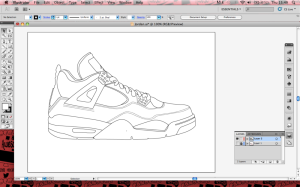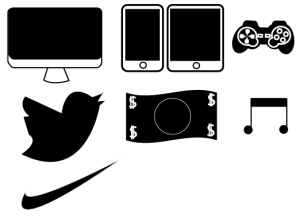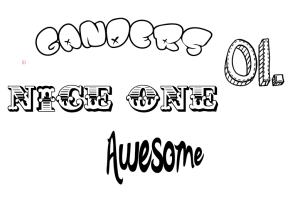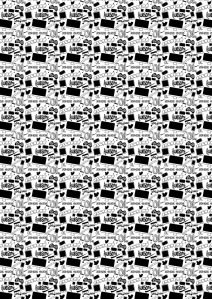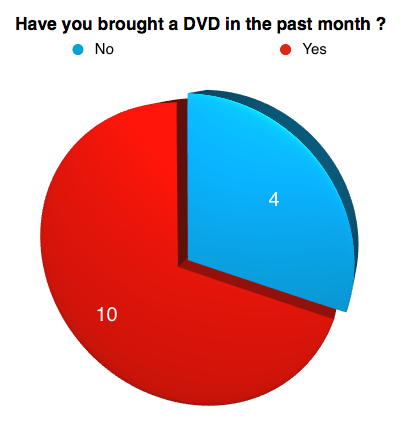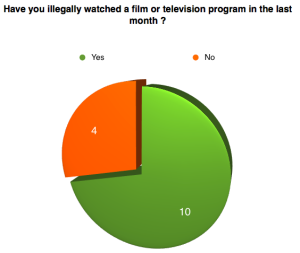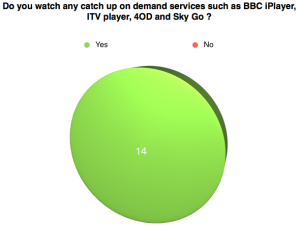In Adobe illustrator, I picked an object in which I re produced. I used the pen tool to copy oveer the object. I used the curve abillity in the pen tool to help me draw over the trainer.
Monthly Archives: November 2012
Typography, Vector and Photographic posters
Successful Poster campaigns
This is one of the most famous poster campaigns and most successful. In 2008, this poster was created by Shepard Fairey for the presidential election. The design of the poster was created in one day where Shepard Fairey then immediatly sold 350 in a street. The poster them became more recognised where it was then widely distributed. The poster was then approved by the official Obama Campiagn making it one of the successful symbols in Obama’s campaign message.
Another successful poster campaign was Batman Arkham City the video game. These posters were advirtised everywhere months before the game was released to show the audeince a glimpse of the characters. These posters are very basic as they feature no text only a single character on a plain white background, This was used to put all the attention on the character. I remember when I saw the first campiagn poster of Batman in black and white showing the bright red blood which I knew straight away was the new relase game and it made me very excited to see the campiagns that followed.
Wallpaper Adobe Illustrator
My task was in Adobe illustrator to design various objects that represent me. Using the skills and techniques I was taught, I used the pen tool to create the shapes as well as the object tool. Once I had created the objects, I made them into individual symbols Which enabled me to use them in my symbol pallette.
After I had created the objects, I played around with the fonts to make various words that I say or represent me. Whilst making the text, I was able to manipulate it by making it bolder, wavy etc. I also made each word into symbols.
I then made 1 tile which would then trasform into a wallpaper, I Started by opening a new project in Illustrator which was 400×400 pixels where I then created a collage of all the words and objects I had made. I made some of the words and object overlap the tile so when I was to reproduce it, It would then show up symetricallly on the next tile. I did this by selecting the object and then went Object > Transform > Move where I then moves the object 400 pixels horizontally or vertically depending on where I wanted it to be placed I then clicked copy where it would copy the object to where I placed it.
After the tile was made, I had to export it and open it in Photoshop, I did this by Making it a define web pattern in photoshop, I then opened a new canvas and selected the paint bucked tool and chose my design, I then simply filled in the canvas and then it automatically made the canvas into my wallpaper.
Process Report
- The Brief ✓
- Response to the brief ✓
- Research into past campaigns ✓
- Research into client ✓
- Marketing Basics ✓
- Qualatative and Quanatitative research ✓
- Schedule ✓
- Research into successful poster campaigns ✓
- Research into techniques of creating posters X
- Write up illustrator work ~
The blog Posts I need to complete are researching into techniques of creating posters and coming up with initial ideas for my three posters.
Gallery
Qualitative and Quantitative Research
In my questionnaire, I put Qualatative and Quantitative questions for people to answer as it would help me undertsnad more about what to do for my campaign.
My first qualitataive question I put was “What was the last campaign poster you saw ?” People responded with various campigns they recently saw which inlcuded Piracy, Animal abuse, Health campaigns such as cancer and air ambulances, and drugs. I followed the question on to say “In what way did it effect you ?” where people would respond with a quantitative answer.
The next set of questions are mainly qualitative so I produced Pie Charts to show the results :
Be Creative Competition Brief
Be ©reative is a unique and exciting production competition for UK students aged 11-19, offering recognition for creative talent plus great prizes for individual winners and their schools.
Working to a real-world creative brief, students research, design and produce an original marketing campaign to encourage young people to choose official film, TV and video and support the UK industry.
Response to the Brief:
The key stages I will follow for this breif is:
- Plan and develop ideas
- Produce
- Presentation and feedback
- Submit to final Boards
- evaluate
To complete these stages, I need to:
- Read the breif so I undertand the task in hand
- Research the client
- Laern about copyright
- Create questionnaires for my target audience
- present data from questionnaire
- Generate ideas for my campaign through Mind maps and spider diagrams
- Create rough designs
- Peer evaluation
- Refine Designs
Marketing Basics
Definitinon of Marketing
‘Marketing consists of the strategies and tactics used to identify, create and maintain satisfying relationships with customers that result in value for both the customer and the marketer.’
http://www.knowthis.com/principles-of-marketing-tutorials/what-is-marketing/d…
In order to be successful in marketing businesses must identify what customers will they serve and how best can they be served or in marketing speak: what is the target market and what is the value proposition?
Target Market refers not just to the target audience but also to the type of market you are attempting to release the product into (competition, similiar products, prices etc.) To establish this you must research. (see below)
The value proposition is the set of benefits or values a company promises to deliver to consumers to satisfy their needs – or, to put it simpler terms, the reasons why consumers should buy the product or service. Establishing the value proposition is tied closely to the brand identity of the company and how they differentiate and position themselves relative to their competition.
Designing your research
The stages of Market Research are as follows:
1. Identify the purpose of the research.
What are you attempting to get from the research? Is it an explanation as to why certain consumer behaviour is occurring? Is it to enable accurate predictions for the future? Is it to monitor current activity and record it accurately? To discover new needs and wants?
2. Design the research
This is far more than just knocking out a questionnaire or an online survey. First you have to ensure that research you are undertaking is valid – that the research really does measure what is it supposed to measure.
Then the research must be reliable – so is the data collected honest, is it a fair recflection of the rest of the chosen group that are being studied.
Then there’s different types of research that can be carried out as depending on the research objective you might need quantitative research or qualitative research. Quantitative research is pursuit of empirical evidence and data using in numerical form.
Qualitative research is finding out the stories behind the facts and figures, trying to understand opinion and motivation of consumers – just what is it about attacking pigs with beaked kamikaze-pilots that is so appealing.
3. Data Collection
The type of data needed has been identified for the purpose of the research, now its about getting the information. This is can be done with collection of original information and data – which is primary research. It can be the gathering and summary of existing research and data – which is secondary research. Typically – for a thorough research project – a combination of primary and secondary is used.
4. Evaluate and analyse the data
Evaluating requires a looking at the raw data and ‘cleansing’ the data in terms of incomplete and unrepresentative responses that might have an affect on the overall outcome.
Analysis can take two forms;
Descriptive analysis – this is a summary of the findings, a description on the data. This could involve pie charts and tables for quantitative research and categorisation of consumers for qualitative.
Inferential analysis – using the data to make inferences, predictions and judgments on the area research.
5. Communicate the results – the final stage is to present your research making clear the purpose of the research, the design, the finding and the conclusions made from it.
Gallery

This gallery contains 1 photo.
Adobe Illustrator In adobe Illustrator, I was given a breif tutorial on how it works and various shortcuts to help me when im using it. I was shown the main tools to use and how to use them, I also … Continue reading

